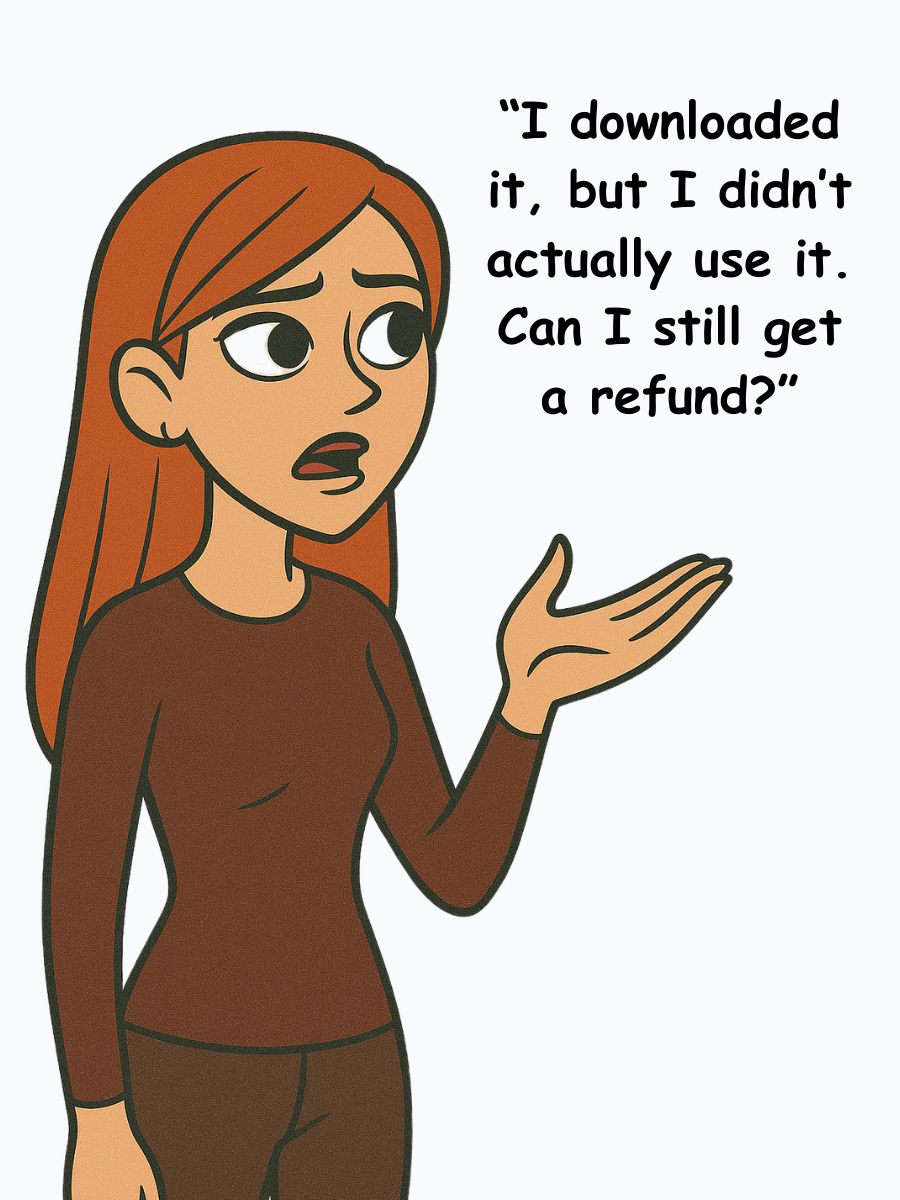7 Must-Haves for an Effective Digital Product Policy (That Most Policies Don’t Include)
What should your digital product policy include? A strong policy protects your content, your boundaries, and your refund policy without being full of confusing legalese.
As a contract lawyer who works with digital product sellers (and sells digital products), I’ve seen firsthand how the lack of proper terms leads to refund disputes, content theft, and even angry emails blaming you for someone’s lack of results. If you’re selling eBooks, workbooks, graphic designs, photos, content, or other digital products, you need an ironclad digital product policy template that’s actually practical to enforce your copyrights, protect against refunds, and avoid legal trouble.
In this blog post, you’ll learn all about what you need in a digital product policy — and why skipping even one of these could leave you exposed to refunds, plagiarism, and even liabilities that could kill your business. We’ll go beyond generic examples and cover the essentials that most free digital product policy templates completely miss.
You’ll learn all about essential clauses any digital product policy template should include.
You’ll discover essentials that you won’t see in most digital product policy examples.
And you’ll get a sneak peek at my terms and conditions for digital products.
After reading this blog post, you’ll walk away knowing how to confidently protect your products, your income, and your brand.
This post is all about the must-haves for your digital product policy to protect your content, money, and business.
Ultimate Digital Product Policy
The Essentials for All Terms and Conditions for Digital Products
1. IP Protection Clauses That Go Beyond Copyright
You’ve put a ton of work into creating your digital products — so it’s only fair you protect them from copycats. But here’s the problem: most digital product policy examples only mention basic copyright ownership in vague legalese. That’s not enough.
You need to clearly spell out what your customers can — and can’t — do with your digital products. Otherwise, people will test the limits, reinterpret your terms, or assume it’s fine to share your files “just this once.”
Here’s what a strong digital product policy should include:
🔒 Clear restrictions on editing. If you’re selling templates, workbooks, or printables, your terms must state that the product can’t be modified for commercial use — no turning it into their own product, even if it’s been edited.
🚫 A strict no-copying, no-reselling rule. Some people love to live in the grey zone. That’s why your policy should also ban derivative works — where someone rewords or slightly changes your content and tries to pass it off as original.
🙅♀️ No “just sharing with a friend” loopholes. Even non-commercial sharing (with a friend, client, or business partner) should be clearly prohibited. Sharing = lost sales — and your terms should make that very clear.
My Terms and Conditions for Digital Products Template includes strong, plain-English clauses that close these loopholes — so you don’t have to worry about vague interpretations.
👉 Want this baked into your terms?
Grab the Digital Product Policy Template →
2. A Refund Policy That Actually Works for Digital Products
Unlike physical products, digital products can’t be “returned” — once your customer has the file, there’s no way to take it back. That’s why your digital product policy needs to include a strong digital product refund policy. But “strong” doesn’t mean one-size-fits-all.
The problem I usually see in the average digital product policy template is that it includes a digital product refund policy template that either (1) doesn’t actually protect you, or (2) is way too rigid for how digital creators sell.
You need language that reflects your business model — whether you offer a strict no-refunds policy or a limited guarantee.
Here’s what your digital product policy template should include:
✅ Option 1: A Clear Digital Product No Refund Policy Template (Recommended)
This is the safest option for most digital product sellers — and it’s what I recommend.
A proper no-refund policy in a digital product policy should:
Waive all statutory “cooling-off” or withdrawal rights that customers may have under consumer protection laws (especially if you’re selling to EU customers).
Clearly state that all sales are final, non-refundable, and non-cancellable — no exceptions.
Apply to both full payments and installment plans (if that’s what you offer).
Give you the right to refuse access or ban future purchases if the buyer tries to abuse the policy or issues a chargeback.
Why it matters: If someone tries to reverse a charge or demand a refund through PayPal or their credit card, you’ll have clear, contract-backed proof they agreed to a no-refund policy.
✅ Option 2: A Conditional “Satisfaction Guarantee”
Prefer to offer refunds within a limited time window? That’s fine too — but your terms need to be very specific about:
How long the refund window is (e.g., 7 or 14 days)
What conditions the buyer must meet to qualify (e.g., “show proof of completing the first module”)
And how much they’ll get back (like, 100% of their money back or 50%?).
This protects you from buyers who:
Download the product
Don’t even use it
And then try to get their money back just because they “changed their mind.”
Pro Tip: A proper template should also specify that admin fees are deducted, define the refund method (e.g., store credit vs. original payment method), and block future refunds for repeat offenders.
Bonus Protections in My Template:
My Digital Product Policy Template provides multiple refund clause options, allowing you to select the one that best suits your business needs. It includes:
Waiver of statutory refund rights
No-refund language for instant digital downloads
Optional conditional refund clause with editable requirements
Clauses for refund abuse, admin fees, and revoking access if payment fails or is reversed
So whether you’re selling a $19 Canva template or a $499 premium guide — you’re protected.
Want a legally solid refund clause that works with your business model?
Grab the Digital Product Policy Template →
3. Download Access Terms (and Expiry Rules)
Your digital product policy needs to set clear rules for how and when your product is delivered — and for how long the buyer can access it.
Without this clause, you leave yourself wide open to:
Endless resend requests
Buyers expecting lifetime access (even if it was a one-time download)
Complaints when buyers do not get access to updates in the future
Here’s what your policy should spell out:
1. When the digital product will be delivered
Your customers need to know exactly when to expect their product, whether that’s:
Immediately after purchase
Within a set number of hours or days
Or on a specific date (for pre-orders or launches)
Setting this expectation upfront helps prevent angry emails and refund requests.
2. How long the download link will remain active
If you don’t limit access:
Some buyers will wait months to open the file until the link no longer works
Other annoying buyers will request new links again and again
That will leave you at a higher risk of customers sharing the download link with others
Your digital product policy should make it crystal clear that:
The download link will expire after a set number of hours or days (e.g., 7 days)
You’re not obligated to resend it if the customer missed the deadline
And any resends (if allowed) are at your sole discretion
This helps enforce boundaries and protects your time.
3. What happens when you update your digital product
Many buyers will assume that if you update the product later, they’ll automatically get the new version too… Even when they only paid once.
Not necessarily. You may choose to provide lifetime access to updates (like I do) — but that does not make sense for every type of digital product. Your digital product policy should clarify this.
Depending on your business model, your policy should state whether:
Future updates are included in the original purchase price, or
Each version is a separate product, and updates are not automatically provided.
This gives you control over how you handle content updates — especially useful if you’re continually improving your digital products and want to offer premium versions for a fee.
The problem with most templates I’ve seen is that they don’t even include a section that clarifies whether customers get access to updates or not.
4. Revoke access if someone violates your terms
Another important clause that should be included in your digital product policy template, but I often don’t see, is that if a customer:
Shares your product
Breaches your refund policy
Or violates your license…
You should reserve the right to:
Revoke their download access
Ban them from future purchases
Or restrict their use of your shop or products altogether.
This clause gives you the legal grounds to act if someone crosses the line.
5. Format and compatibility disclaimers
You’re responsible for delivering the product — not for tech support.
Your terms should clarify:
The format of the product (PDF, ZIP file, editable template, etc.)
The tools/software required to open it
And that it’s the buyer’s responsibility to make sure they can access and use the file properly.
This protects you if someone tries to request a refund just because they didn’t read the product description or open it on an unsupported device.
My Digital Product Policy Template provides flexible options for delivery timelines, download expiration, update access, and product format, enabling you to tailor it to perfectly match your setup.
Want to make sure your delivery terms and update policy are airtight?
Grab the Digital Product Policy Template →
4. Disclaimers and Limitations of Liability (So You’re Not Held Responsible for How People Use — or React To — Your Work)
Whether you’re selling an eBook, a workbook, stock photos, Canva templates, or digital art — one thing is always true: once it’s out in the world, people will interpret your product in all kinds of ways — sometimes in ways you can’t control. That’s why your digital product policy must include clear disclaimers and limits on liability.
These clauses aren’t just legal padding — they protect you from being blamed, sued, or publicly dragged if:
Someone misapplies your advice
Doesn’t get the results they expected
Or is offended by what you created
Here’s what disclaimers your digital product policy should include:
1. A general liability disclaimer
Your digital product policy template should at least include a catch-all that says:
You don’t guarantee the product is perfect, error-free, or 100% up-to-date
You reserve the right to make changes at any time
The buyer is using the product at their own risk
2. No professional relationship or advice
If your product is informational (like a guide, checklist, or coaching resource), your digital product policy should include a digital product disclaimer template for your specific niche, like:
Wellness, fitness, health, or nutrition disclaimers
Therapy, psychology, or mental health disclaimers
Finance, business advice, or legal guidance disclaimers
You must include niche-specific disclaimers that:
Clearly state that the product is for informational or educational purposes only
Explain that no client or professional relationship is created
Clarify that it’s not a substitute for professional advice, diagnosis, or treatment
Confirm that individual results may vary
Example: If someone uses your journaling workbook and claims it made their anxiety worse, or buys your financial checklist and blames you for missing a tax deadline — these disclaimers help protect you.
However, most generic digital product policy templates don’t include any niche-specific disclaimers at all.
3. Outcome and results disclaimers
Even if your product doesn’t fall into a “sensitive” niche, you still need to make it clear that:
You don’t guarantee results
Success depends on the buyer’s own effort, application, and personal circumstances
You’re not responsible for their choices, outcomes, or financial results
This protects you from complaints and refund requests stating “Your content didn’t help me,” or “I followed your guide and still didn’t make any sales.”
4. Offense and content disclaimers
If you sell photos, visual artwork, design files, templates, or videos that include:
Nudity or body-positive themes
Political or religious commentary
Satirical, profane, or (even slightly) controversial content
Then, this disclaimer is essential.
It should make it clear that:
The product may include sensitive or provocative topics or imagery
The content is not intended to offend or cause harm
You’re not liable for how someone emotionally responds to your content
This protects you if someone downloads your design and complains that it’s “too political,” “not safe for work,” or “triggering.” Whether it’s a sassy quote pack or an edgy T-shirt mockup, this clause helps you set expectations.
5. No guarantees or representations
Finally, your disclaimers should end with a clause that says:
You make no warranties, guarantees, or promises about outcomes
Any positive feedback or success stories are individual results, not guarantees
It’s about setting realistic expectations — and protecting yourself if someone takes your content too literally.
My Digital Product Policy Template includes all of these disclaimers — including niche-specific options for:
Health and wellness products
Coaching or mindset tools
Legal, financial, or business-related resources
Graphic design and illustration assets
Sensitive or controversial creative content
You can simply plug in the ones that apply to your product — and delete the rest.
Want to protect yourself from misinterpretation, misuse, or misaligned expectations?
Grab the Digital Product Policy Template →
5. Brand Protection & Non-Disparagement Clauses
You’ve worked hard to build your brand — your tone, your aesthetic, your name. So the last thing you need is a buyer misrepresenting your product, claiming your endorsement, or dragging your name because they didn’t like your digital product.
A strong digital product policy isn’t just about refunds and licenses — it’s also about protecting your reputation and setting clear boundaries around how your business and brand can (and can’t) be used.
Here’s what to include:
1. A non-disparagement clause
This clause prevents customers from publicly bad-mouthing your:
Products
Services
Brand
Or you personally
It’s especially useful if someone:
Gets mad because you denied a refund
Misunderstood what the product was supposed to do
Or simply didn’t like your tone, style, or design
Your clause should state that they cannot:
Make negative claims
Post defamatory reviews or comments
Harm your business reputation
— regardless of the reason.
This clause doesn’t stop honest feedback — but it does give you protection if someone crosses the line.
2. No false endorsements or affiliations
Your terms should prohibit customers from implying that you:
Endorsed them or their business
Have a coaching or mentoring relationship with them
Are affiliated with their work or brand in any way
Approved how they used your product (especially with templates, graphics, or visuals)
This is crucial if you sell:
Branding kits
Business templates
Legal or financial checklists
Any editable digital product
3. No misrepresentation of your content or business
Buyers should also be barred from:
Reposting your work out of context
Quoting you in misleading ways
Suggesting you are a partner or sponsor of their project
Using your name or brand in their own promotional materials
This helps ensure that your words, designs, and ideas aren’t taken out of context — or used to market something you don’t want your name attached to.
All of these protections are baked into my Digital Product Policy Template.
Want to make sure no one misrepresents your brand or drags your business name through the mud?
Grab the Digital Product Policy Template →
6. Enforceable Jurisdiction & Arbitration Clauses (So You’re Not Dragged to Court in Another Country)
When you sell digital products online, your customers could come from anywhere in the world. That’s great for business — but risky if there’s ever a dispute.
Why? Because without the right legal clause in your digital product policy, you could be dragged into court in a country you’ve never set foot in — under a legal system you’ve never heard of.
This is where most templates fall short. They’ll include either a simple “choice of law” clause or an arbitration clause — but not both. And certainly not in a way that adapts to where your buyer is located.
Here’s why that’s a problem — and how my clause solves it.
Why arbitration is better for international disputes
Let’s say someone in another country sues you over a $49 digital product. If you only have a court jurisdiction clause, you’d first need:
A ruling from your local court
And then approval from the customer’s court to actually enforce it
That means more time, more paperwork, and way more legal costs.
That’s why my digital product policy includes an international arbitration clause for disputes with buyers located in another country. Why?
Arbitration awards can be enforced globally
It avoids having to deal with unpredictable national court systems
It’s a more practical and realistic way to resolve cross-border disputes — even if it’s not always cheaper
Why court proceedings are better for local disputes
Now, what if the buyer is located in the same country as you?
In that case, my template switches to national court proceedings, which are typically:
Cheaper and faster than arbitration
More familiar and straightforward to navigate
Already enforceable without additional steps
For example: If you’re based in the U.S. and a U.S.-based buyer wants to sue you, the clause makes clear that the dispute must be handled in your state and court, not theirs.
Why you need both — not just one
Most templates only include one type of dispute resolution:
A generic arbitration clause (with no fallback), or
A basic “governing law” and court clause, which doesn’t work well internationally
But that’s a huge gap.
If you only rely on court proceedings and someone sues you from another country, your court ruling might not even be enforceable without re-litigating the whole case abroad.
My template is different. It includes a dual-layered clause that:
Sends international disputes to arbitration (so they’re enforceable worldwide), and
Keeps local disputes in court (so they’re faster and cheaper for you)
The best part? My Digital Product Policy Template lets you plug in:
Your country or state of registration
Your preferred city for legal proceedings
And it includes a jurisdiction clause tailored for EU sellers (so it works across Member States too)
Want to make sure you’re not dragged into court halfway across the world over a $39 download?
Grab the Digital Product Policy Template →
7. Platform-Agnostic Formatting (So You’re Covered — No Matter Where You Sell)
Whether you sell on your own WordPress website, Squarespace, Stan, Shopify, Gumroad, Podia, or your own custom website — your digital product policy should work for any platform.
Unfortunately, many “free” or outdated templates are written with just one platform in mind. That’s a problem, because:
You may sell on multiple platforms at once
You might switch tools later
Some platforms don’t support built-in policies — so you need to provide your own legal terms at checkout
That’s why your digital product policy should be platform-agnostic — written to apply no matter where or how you sell.
Your terms should say how the product will be delivered — but without locking you into a specific method.
That way, you can update your delivery method without having to rewrite your entire policy.
My Digital Product Policy Template is designed to be platform-agnostic from the start.
You choose the delivery method
You fill in your platform name (or leave it general)
You stay legally protected whether you use one platform or ten
👉 Want a policy that works across platforms — so you never have to rewrite it when your business grows?
Grab the Digital Product Policy Template →
The Ultimate Digital Product Policy Template
The right digital product policy doesn’t just protect a PDF — it protects your income, your boundaries, and your reputation.
It draws a clear line between what buyers can and can’t do with your digital product. It backs you up when someone demands a refund, misuses your content, or shares it without permission. And it ensures your terms apply — whether you sell on Stan, Gumroad, Squarespace, or all of the above.
If you’re selling digital products (or getting ready to), don’t leave your business exposed to vague terms, refund loopholes, or international legal messes.
✅ Use the same lawyer-drafted template I give to my clients to protect their shop — in under 30 minutes.
Get the Digital Product Policy Template →
This post was all about the essentials you need in your digital product policy to protect your content, money, and business.
Want to learn more about everything you need in your digital product policy? Read these blog posts next:





